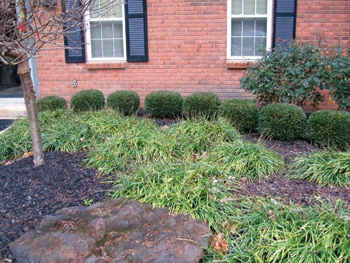Dear Jim Dulley: We just built a house, and it needs a lot of landscaping. I want to plan and plant it all myself. I’ve heard proper landscaping can impact my utility bills. What are some basic efficient landscaping tips? — Janice S.
Dear Janice: People tend to appreciate landscaping for its aesthetic value, but proper landscaping also impacts the energy efficiency of your house. From an overall environmental standpoint, good landscape design also minimizes the need for mowing and other lawn care. In addition to increasing the efficiency of your home, wise landscaping can reduce the need for watering.
Proper landscaping includes the use of ground cover, dwarf and full-size shrubs, climbing vines and trees. Ground cover is typically some type of plant, grass or gravel. The selection you make depends on your climate and specific house. Within the same neighborhood, a combination that works best for one house may not be the best for a home just one street away.
In general, try to use low-growing ground cover plants or gravel instead of grass. Other than some unique types of grass, most common species of grass require maintenance. Grass is still the best choice for areas of your yard where children play or pets roam, but try to keep it to a minimum.
In all but the most humid climates, placing low-growing ground cover plants near your house helps keep it cool during summer. The leaves block the sun’s heat from being absorbed into the ground, and they give off moisture. This evaporation of water from the leaves, called transpiration, cools air near the home—similar to when we perspire.
In hot, humid climates, gravel that is shaded from the sun can be more effective than ground cover plants. Using gravel also eliminates the need for watering, but it may increase the air temperature around your house. The thermal mass of the gravel stores the afternoon sun’s heat, causing the heating effect to last into the evening. Though not helpful during summer, gravel provides an advantage during winter.
When selecting ground cover plants, consider their specific characteristics (mature size, water needs, propagation, foliage density, etc.) To minimize the watering requirements, group the plant types based on their watering needs.
Dwarf shrubs are ideal for energy-efficient landscaping because they remain small at maturity (2 to 3 feet high). Plant some near the house foundation and some farther away for windbreak ramps. Since they stay small, they require little care and little watering.
In addition, dwarf shrubs can cut your utility bills year-round. The sill plate, the bottom frame along a home’s foundation, remains one of the greatest air infiltration pathways into many houses. Planting dwarf shrubs near the house, especially evergreen varieties, can block the force of cold winter winds and reduce the amount of air leaking in.
As a windbreak ramp, dwarf shrubs can be planted to the northwest side of taller shrubs and trees. These smaller plants begin directing the cold winds upward toward the tops of taller trees. The upward wind path continues over the top of your house, not against it.
Planting climbing vines on a trellis can create effective shading to reduce the heat buildup on a wall during summer. In most climates, locate the trellis close to the house to also take advantage of transpiration cooling. In humid climates, locate the trellis a little farther away from the wall. This allows the airflow to carry the moisture away but still provides good wall shading.
Climbing vines are often more effective than trees for shade because you can target specific windows and areas of your house where heat produces the greatest problem. Deciduous vines, which lose their leaves during winter, are best so the winter sun still reaches the house. One with a robust stem structure can help disrupt the force of winter winds.
Trees have perhaps the greatest effect on your utility bills. The actual landscaping details vary for different climates, but some general concepts apply to all. Evergreen trees are effective for the northwest across to the northeast side of a house to block the winter winds. During winter, the sun does not shine from those sides. Deciduous trees planted on the other sides provide summer shade but allow the winter sun through. You may want to leave a small gap to the southwest to allow summer breezes to reach your home.
————–
James Dulley writes a syndicated column about home energy efficiency.

